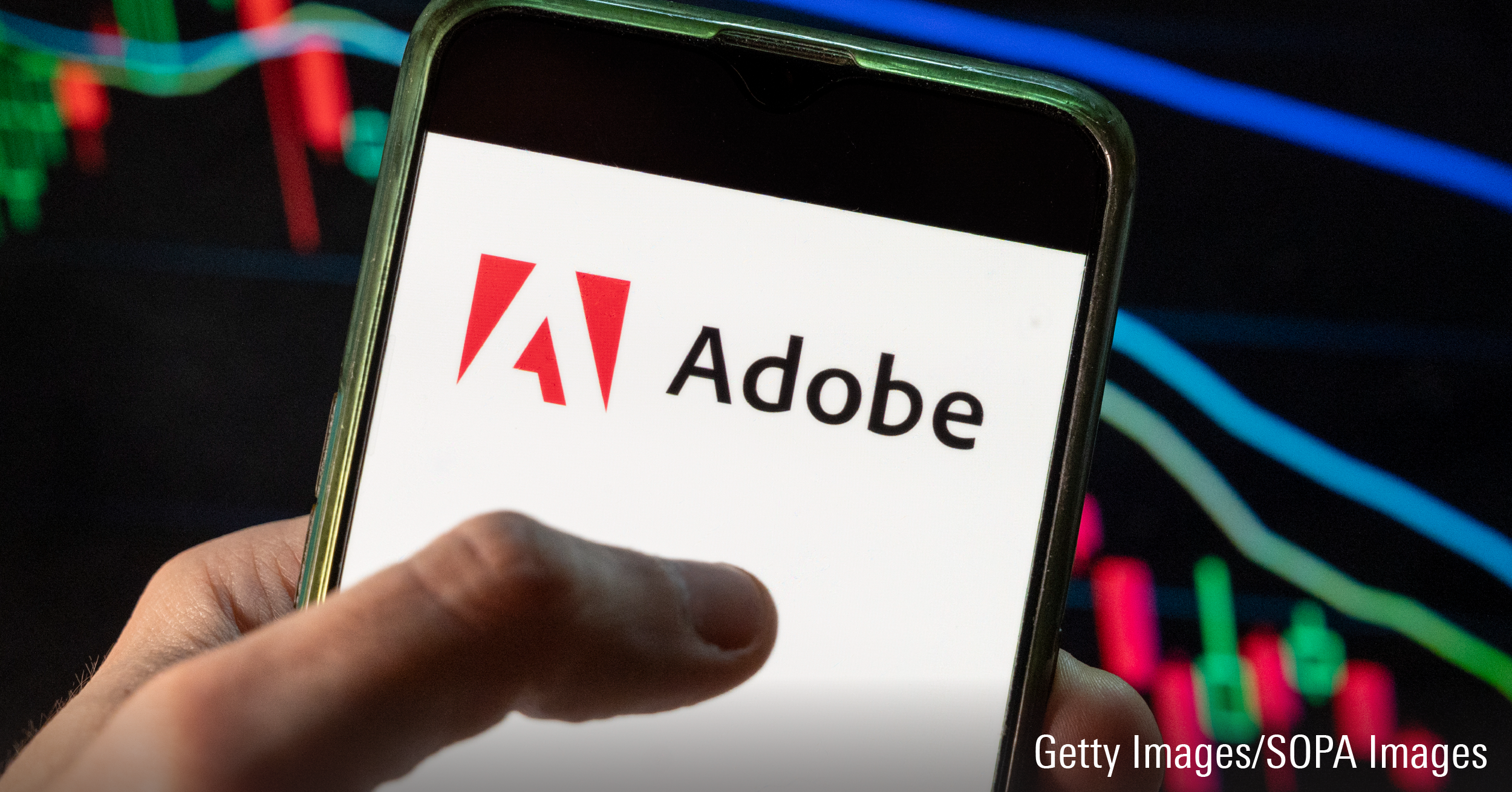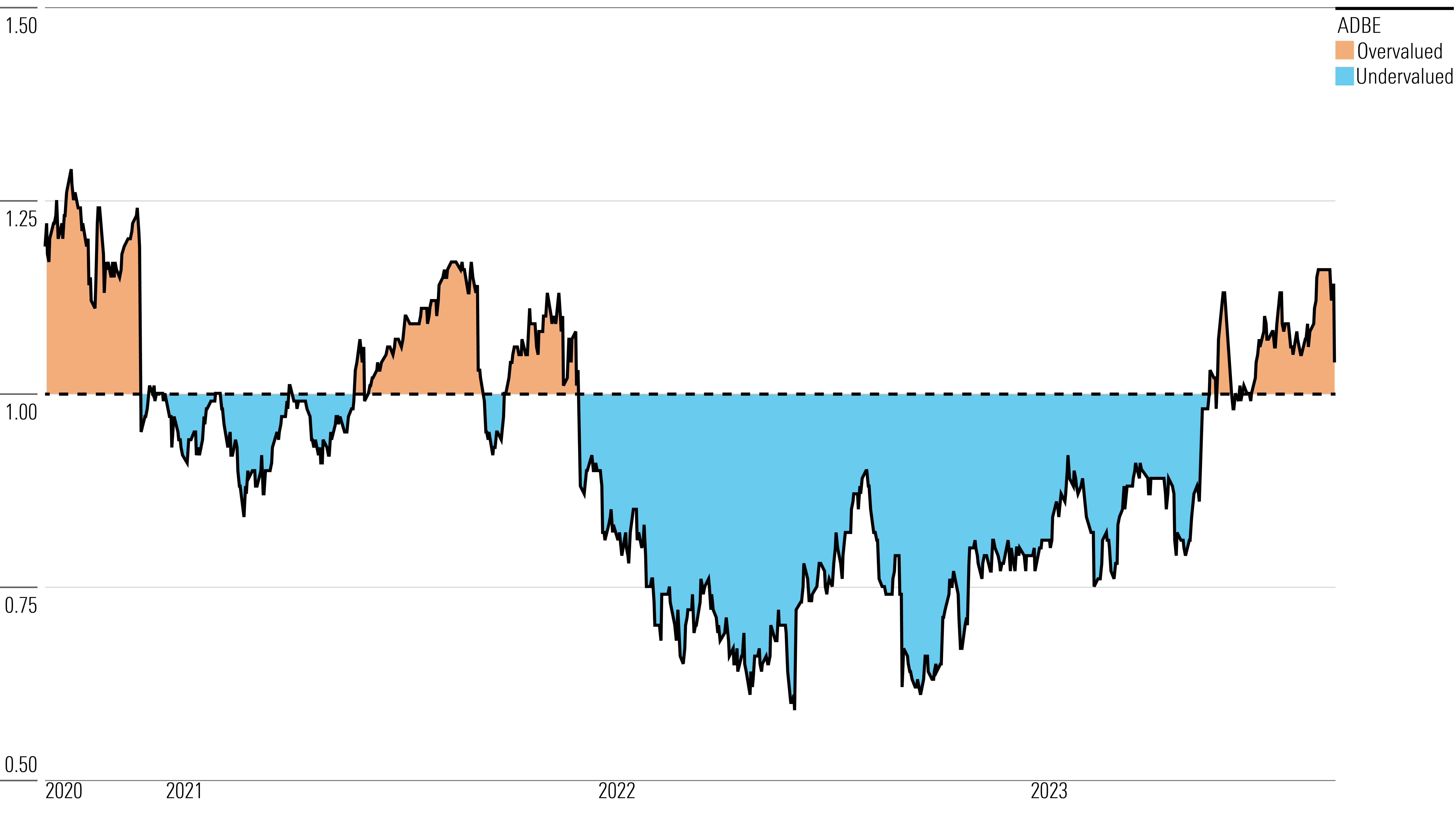After Earnings, Is Adobe Stock a Buy, a Sell, or Fairly Valued?
With good results and strong revenue growth, here’s what we think of Adobe stock.

Adobe ADBE released its third-quarter earnings report on Sept. 14, 2023, after the market close. Here’s Morningstar’s take on Adobe’s earnings and stock.
Key Morningstar Metrics for Adobe
- Fair Value Estimate: $510.00
- Morningstar Rating: 3 stars
- Morningstar Economic Moat Rating: Wide
- Morningstar Uncertainty Rating: High
What We Thought of Adobe’s Q2 Earnings
- Overall, there are plenty of positives. Results were good, with upside to both headline numbers and underlying strength coming from net new creative annual recurring revenue and remaining performance obligation. Creative Cloud and Acrobat drove nearly all the strength, per our model.
- Both revenue and non-GAAP earnings per share were ahead of expectations. Most of the upside came from digital media.
- Adobe is a high-quality company with one of the widest moats we see within software. Management excels at operational excellence, capital allocation, and consistently delivering quarterly results for investors. Near-term catalysts include the MAX investor day in October, the company’s full-year 2024 guidance, and updates on the Figma acquisition, which was left for dead but may be back on to close by Nov. 30, 2023. These catalysts could be negative as well—for example, if guidance falls short of investor expectations.
- The stock is fairly valued at this point, pending updates from these catalysts over the next several months.
Adobe Stock Price
Fair Value Estimate for Adobe
With its 3-star rating, we believe Adobe’s stock is fairly valued compared with our long-term fair value estimate.
Our fair value estimate for Adobe is $510 per share, which implies a fiscal 2023 enterprise value/sales multiple of 11 times and an adjusted P/E multiple of 32 times.
We model a five-year revenue CAGR of approximately 12%. We foresee solid growth in both digital media and digital experience, even as both steadily slow over time. Digital experience should benefit from 2023 price increases that should filter in over the course of several years, as well as increasing penetration into a $110 billion market.
We believe a relatively frictionless cross-selling opportunity exists for the company, as creative professionals are already steeped in Adobe products. The desire to consolidate vendors makes Adobe an obvious choice for needed marketing software solutions, and the fact that its products are strong should help initially in what we believe is a large greenfield opportunity.
Within digital media, we have been impressed by Adobe’s ability to draw in new users that many did not believe existed. We believe some of this is related to piracy, which is effectively eliminated in the software-as-a-service model.
Additionally, the company has had success upselling existing users to higher price point products and cross-selling acquired technologies, such as Workfront and Frame.io. We believe continued innovation, gathering new users, and upselling existing users in Creative Cloud should help drive strong growth for the next several years.
Read more about Adobe’s fair value estimate.
Adobe Historical Price/Fair Value Ratios

Economic Moat Rating
For Adobe overall we assign a wide moat, arising from its switching costs and network effects. Based on the company’s segments, we believe digital media has a wide moat because of switching costs and network effects, digital experience has a narrow moat arising from switching costs, and publishing has a narrow moat based on switching costs.
Digital media represents approximately 70%-75% of revenue. This segment contains Creative Cloud, which is nearly 50% of revenue, and Document Cloud, which is approximately 10%. Creative Cloud is composed of the iconic products Photoshop, Premiere, Illustrator, InDesign, After Effects, Fireworks, XD, and Dreamweaver, among others, and a variety of mobile versions of these products and additional discrete mobile solutions. Document Cloud consists of the Acrobat family of products, including Scan and Sign.
Since its introduction in 1989, Photoshop has become the industry standard for image editing software. Rather than remaining complacent, Adobe has consistently invested in the solution, introducing new features and adding applications, both developing them internally and bringing them in through acquisitions. Notably, Fireworks and Dreamweaver came from the 2005 Macromedia acquisition, while InDesign and PageMaker came from the 1994 acquisition of Aldus. More recently, Adobe acquired Allegorithmic for 3D texturing, Workfront for workflow management, and Frame.io for video workflow.
Over the years, Photoshop, Illustrator, Premiere, InDesign, and After Effects have been the company’s most popular products, and beginning in 2003 they became available together through the Creative Suite bundle. While that bundle no longer exists, we believe these same products drive the bulk of demand in Creative Cloud. Other products serve more specialized needs or tend to be in more emerging technology areas within graphics, such as 3D illustrating.
Read more about Adobe’s moat rating.
Risk and Uncertainty
We assign Adobe a Morningstar Uncertainty Rating of High. It faces risks that vary by segment. Creative Cloud’s high market share over the last 25 years means a significant portion of high-margin revenue would be at risk (however slight) if a competitor were to make inroads in the space. The dampening of cross-selling opportunities with digital experience would likely then be diminished, which would be problematic, as it represents the larger growth opportunity over the next five years, in our view. While Adobe is generally considered a leader in the various categories included under its digital experience umbrella, it did not create any of these categories and does not dominate them the way it does with Creative Cloud.
Adobe has built its digital experience business largely through acquisitions. The two recent acquisitions of Magento and Marketo also pose risks, as they were on the larger side for the company. Any integration missteps could potentially cause delays in new contract signings. Further, material missteps could possibly result in substantial write-downs regarding these (or other) acquisitions. While the margin structure may ultimately be lower in digital experience than in Creative Cloud, the company has worked to improve margins over time, and we believe Adobe must continue to drive down costs and expand margins to meet investor expectations.
Read more about Adobe’s risk and uncertainty.
ADBE Bulls Say
- Adobe is the standard in content creation software and PDF file editing—categories the company created and still dominates.
- The shift to subscriptions eliminates piracy and makes revenue recurring while removing the high up-front price for customers. Growth has accelerated and margins are expanding from the initial conversion inflection.
- Adobe is extending its empire in the creative world from content creation to marketing services more broadly through the expansion of its digital experience segment. This segment should drive growth in the coming years.
ADBE Bears Say
- Momentum is slowing in Creative Cloud after elevated growth driven largely by the model transition to SaaS.
- There is greater uncertainty in digital experience, as this is an emerging space that Adobe neither created nor dominates. Growth could be slower than we anticipate, or margin expansion may not materialize.
- Digital experience has been built largely through acquisitions, including Magento and Marketo in 2018. This raises the possibility of disruption from inadequate integration efforts and lends credence to concerns that Adobe may overpay for increasingly large deals.
This article was compiled by Monit Khandwala.
The author or authors do not own shares in any securities mentioned in this article. Find out about Morningstar’s editorial policies.


/cloudfront-us-east-1.images.arcpublishing.com/morningstar/K36BSDXY2RAXNMH6G5XT7YIXMU.png)
/cloudfront-us-east-1.images.arcpublishing.com/morningstar/BG4IFJHA25B6RKD3XNUYKROBBM.jpg)
/cloudfront-us-east-1.images.arcpublishing.com/morningstar/4QBQ2NBJMFG5HGQTDEYCXY5OOI.jpg)